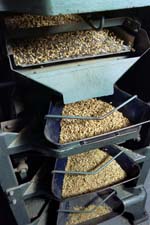
Caption: Barley seeds are sifted and sorted by size by this machine at UW-Madison's Barley and Malt Laboratory. David Peterson, research leader for the lab, says the lab's small-scale malting plant can recreate the conditions of even the biggest malting operations. The lab also has a nifty little five-gallon brewery, capable of turning their malts into a drinkable final product.
Photo by: Jeff Miller
Date: 10/99
High Resolution JPEG 300 DPI

Caption: Barley seeds begin to sprout roots. The lab houses shelves and shelves of more than 10,000 plastic containers full of malt and barley. The lab, created by the U.S. Department of Agriculture, got its start analyzing malt and barley after the 13-year period of Prohibition. Its work is key to a brewing industry that depends on product consistency.
Photo by: Jeff Miller
Date: 10/99
High Resolution JPEG 300 DPI

Caption: Liquid malt extract is filtered into glass beakers. Malting begins in a steep tank, where kernels are left in 57-degree water to soak to 45-percent moisture. Then they are placed in a big metal drum to germinate for another five days, just long enough for the rootlets to emerge. Finally the samples are placed in a kiln that forces warm air through the kernels, drying them for preservation.
Photo by: Jeff Miller
Date: 10/99
High Resolution JPEG 300 DPI


